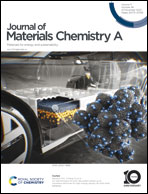Regulating the solvation structure with N,N-dimethylacetamide co-solvent for high-performance zinc-ion batteries†
Abstract
The cycling life of aqueous zinc-ion batteries (AZIBs) is primarily limited by the reactivity of water molecules in the aqueous electrolyte. Here, it is demonstrated that by regulating the solvation structure of the electrolyte, the issues faced by both the negative and positive electrodes can be simultaneously addressed. We have demonstrated that N,N-dimethylacetamide (DMA) benefits from its non-protic polar solvent characteristics, making it a highly suitable co-solvent for hybrid electrolytes. DMA molecules tend to occupy internal solvation shells around Zn2+. The solvation structure with DMA molecule coordination can significantly suppress the activity of water molecules by reducing the number of coordinated water molecules, effectively preventing parasitic reactions at the anode and H+ co-insertion at the cathode (NH4V4O10). With this optimized electrolyte (DMA20), the NH4V4O10//Zn full cell can achieve stable cycling for 2000 cycles at a current density of 3 A g−1 with a capacity retention rate of 78%.



 Please wait while we load your content...
Please wait while we load your content...